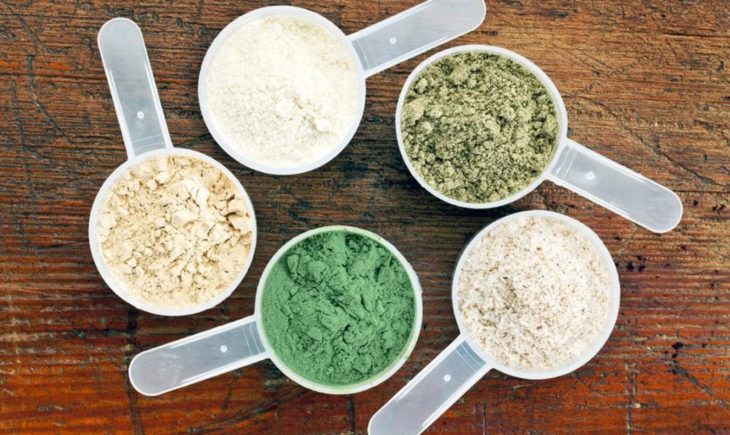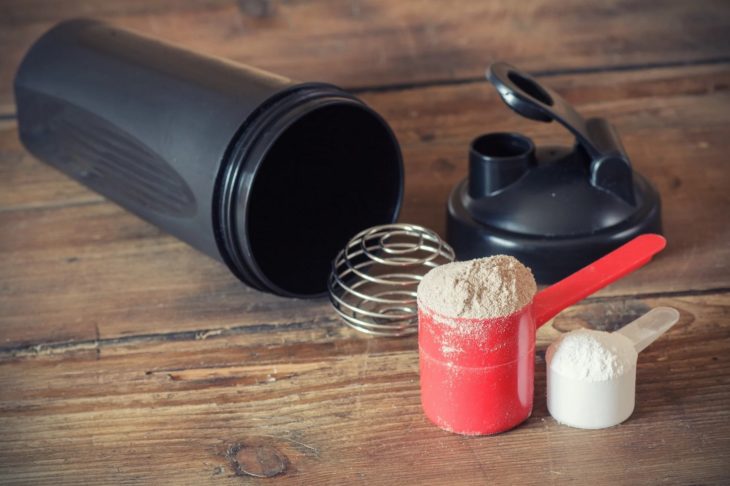If you are interested in building muscle, you may have been hearing about a protein called casein. But what is it? What does it do? And how can it help?
By the time you finish reading this article, you will understand what casein protein is and how it can help you build and maintain muscle and aid in muscle recovery.
Contents
What Is Casein?

Source: Woman’s Day
Casein is one protein in a larger group of phosphoproteins. These proteins are commonly found in mammalian (dairy) milk.
This is important because today, the term “milk” is often used to describe a whole host of products made from nuts, oats, hemp, and even bananas!
Casein and whey are the two most important proteins in dairy milk, and they each have a different essential function. It represents approximately 80 percent of proteins in dairy milk, and whey makes up the other 20 percent.
If you think of the process used to make cheese, it can help you visualize the difference. The whey is the liquid created when the enzymes and the dairy milk interact. The casein is the solids – what are often called curds.
Why Is This Protein Important?

Source: Transparent Labs
As an animal-derived protein source, casein is what is called a “complete protein.” But what does this phrase mean?
The phrase complete protein means that the protein source will deliver 100 percent of the required amino acids to protect, maintain, and repair your body.
But amino acids aren’t the only beneficial element.
Casein also contains beneficial peptides, bioactive compounds, and proteins. Some of these have anti-hypertensive, anti-oxidant, analgesic, immune-protective, and anti-microbial properties.
The protein is also able to bind to calcium and phosphorus, helping these two important nutrients to remain in your body longer and be fully absorbed and used.
Meet the Two Main Types

Source: canadianprotein.com
Casein itself comes in two main types or forms:
1. Micellar
This form digests slowly in the body. It is the natural form and has natural non-catabolic properties.
The term “non-catabolic” means that it doesn’t break down the muscles as it breaks down to be digested and absorbed.
Micellar casein tends to be the most popular for building and repairing muscle and preventing muscle breakdown because it is slowly digested over some time.
2. Hydrolysate
This form digests rapidly in the body because it is pre-digested.
Hydrolysate casein doesn’t necessarily have the degree of muscle protective properties that the micellar form has. Still, since it is pre-digested, it is a fantastic way to deliver a protein boost quickly.
How to Choose Between Micellar and Hydrolysate

Source: verywellfit
Unlike so many decisions you have to tackle when working towards muscle-building goals, this isn’t an either/or decision.
You can take both micellar and hydrolysate casein and derive the unique benefits each has to offer you.
Here is a “real world” example to explain how this might work:
You have just finished an awesome workout, and you want to protect your muscles from the natural post-workout breakdown process. So you take in some of the hydrolysate version immediately following your workout.
Later that night, after a good dinner and relaxation, it is time to sleep. You take some micellar casein right before you go to bed. You do this knowing that the micellar proteins will be digested and absorbed slowly by your body over a period as long as seven hours.
This means your muscles will be getting replenishing amino acids, peptides, and bioactive compounds to prevent breakdown and aid in repair and recovery all night long. So when you go to do your next workout, your muscles will be feeling great and ready to work.
Casein Protein Digests Slowly For Optimal Muscle Building

Source: Healthline
Understanding exactly how this protein works in your body, there are two terms to become familiar with: time release and anti-catabolic. We mentioned both terms here earlier, so let’s dive in deeper with each now.
1. Time-release
Casein is slow to digest, time-release protein. What might this look like in your body?
Let’s say you are just waking up from a restful night of sleep. You haven’t eaten in eight hours. Normally, your body would be taking the nutrients it needs to do its overnight repair work from your muscles.
But before you went to bed, you took some protein (micellar).
So instead of taking nutrients from your muscles, your body has been getting all the nutrition it needs from the micellar casein you took. Research has demonstrated how this slow digestion rate can be beneficial to muscle building and repair.
2. Anti-catabolic
Anti-catabolic is a lesser-known term that is sandwiched in between two terms you are probably quite familiar with: anabolic and catabolic.
Anabolic means the “building up” of muscle.
Catabolic means the “breaking down” of muscle.
Anti-catabolic, then, means prevention of the breaking down of muscle.
So when something is said to be anti-catabolic, it refers to how it can keep the muscles from being impacted by the body’s need for nourishment.
More importantly, if casein is taken in its micellar form, this protection can extend for many hours. While it is a particularly popular supplement to take right before bed, there are other times when this anti-catabolic property can be equally useful, such as in these situations:
- Before a long flight.
- During the workday.
- During times when you are recovering from an injury and can’t work out.
- When you are working to reduce body weight while building muscle.
Casein Is a Great Tool for Muscle Building

Source: pinterest
Thus far we have been talking about how to protect against muscle breakdown.
But casein is also a fabulous aid to muscle building. There are many reasons for this. But one of the best-documented reasons is its high levels of leucine, which is an amino acid particularly important for muscle-building.
When might this be especially important or beneficial? One area is when you are aiming to reduce body fat diet but don’t want to lose muscle mass. You can add casein to your dietary regimen as an easy way to get the protein that is 100 percent useable by your body.
While you will likely notice short-term muscle mass increase, the most valuable benefit may be in its ability to enhance muscle mass over time.
In the Journal of Nutrition, researchers specifically noted that research study participants who took casein protein not only increased in muscle mass but also increased their strength by an average of 20 percent.
How to Start Taking Casein Protein

Source: bodyscienceusa.com
Now you know why you don’t want to ignore these valuable proteins for building muscle. But how should you start adding it to your muscle-building regimen?
Always start by following the guidance of your health provider or the manufacturer’s instructions. Start with the lowest recommended amount and see how your body responds before increasing it. Click here for a list of recommended products.
If you are being treated for any health condition, it is always smart to talk with your doctor first.
